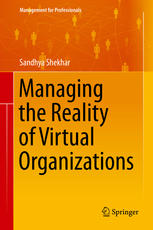Managing the Reality of Virtual Organizations 1st Edition by Sandhya Shekhar 8132227352 9788132227359
$50.00 Original price was: $50.00.$25.00Current price is: $25.00.
Managing the Reality of Virtual Organizations 1st Edition by Sandhya Shekhar – Ebook PDF Instant Download/DeliveryISBN: 8132227352, 9788132227359
Full download Managing the Reality of Virtual Organizations 1st Edition after payment.

Product details:
ISBN-10 : 8132227352
ISBN-13 : 9788132227359
Author: Sandhya Shekhar
This book comes at a time when virtual organizations (VO), are proliferating exponentially due to the twin catalysts of globalization and technological enablement. It provides conceptual frameworks and simple tools for identifying and addressing the complexities of managing geographically dispersed, virtually linked organizations, which may have grown organically or inorganically into a potpourri of multiple cultures, capabilities and practices. These can help to scientifically assess the impact of virtualization, balance the physical with the virtual and manage risks using early indicators. The book provides mechanisms to recognize, localize, measure and address vulnerabilities. Ensuring knowledge transfer effectiveness (KTE) is vital in VOs. A diagnostic tool has been evolved to measure KTE, isolate problems and weak links and plan effective interventions. A set of critical factors to increase the probability of success of globalization strategies have been identified. This book interleaves theory with practice and provides insights drawn from conversations with business leaders, exploratory surveys, and in-depth research using a large sample. The solid methodological underpinnings serve as a useful template for researchers, while the models can be contextualized to suit any organization. Foreword by Mr. Ajit Balakrishnan, Chairman and CEO, Rediff.com; Chairman, Board of Governors, Indian Institute of Management Calcutta.
Managing the Reality of Virtual Organizations 1st Table of contents:
1: Introduction
1.1 The Overarching Motivation for This Book and What It Seeks to Address
1.2 What This Book Is Not About
1.3 How This Book Has Been Organized
1.4 Who Should Read This Book
Reference
2: Virtuality and the Reality of It All
2.1 Geosourcing
2.2 Off-shoring and Organic Growth in Multiple Geographies
2.3 Inorganic Growth
2.4 Extended Value Chain Linkages
2.5 E&M-Commerce
2.6 Virtual Banking
2.7 E-Government
2.8 e-Learning
2.9 Telecommuting
References
3: Virtuality and Virtual Organizations – The Conceptual Edifice
3.1 The Approach
3.2 Toward an Inclusive Definition of the VO
3.2.1 Rationale for the Proposed Approach
3.2.2 An Interpretation of the VO Based on the Resource-Based Theory
3.3 Existing Representations of Degree and Dimensions of Virtuality
3.4 Directionality and Granularity of Virtuality
3.5 Facets of Virtuality
3.6 The Integrated Model
3.7 Measuring DoV
3.8 Understanding Virtual Organizational Maturity (VOM)
3.9 Implications of the Model and Making It Work for You
3.10 Conclusions
References
4: A View from the Top – Conversations with Business Leaders
4.1 The Lulu Group
4.2 Marriott International
4.2.1 Company Overview and Growth
4.2.2 Insights from Marriott’s Growth Strategies
4.2.3 Measuring Knowledge Transfer Effectiveness
4.2.4 Virtualization
4.2.5 Inorganic Growth
4.3 Grundfos
4.4 The Patterns That Emerge
References
5: Bridging Distances in the Virtual Organization
5.1 Understanding Distances
5.1.1 Capability Distance
5.1.2 Cultural Distance
5.1.3 Organizational Distance
5.1.4 Temporal Distance
5.1.5 Social Distance
5.1.6 Environmental Distance
5.2 A Framework for Assessing Distances
5.3 Managerial Implications of Assessing Distances
5.4 The Structural Underpinnings of a VO
5.4.1 The VIPs
5.4.2 The SoI
5.5 A Framework for Linking SOI to Distance Factors
5.6 Industry Implications and Use
5.7 Measuring Distances
5.8 Knowledge Distance as an Input for Evaluating Partner Viability
5.8.1 A Methodology for Assessing Knowledge Distance
5.8.1.1 Methodology
5.8.1.2 Knowledge Score Interpretations
5.8.2 The Model
5.8.3 Managerial Implications
5.8.4 Other Potential Uses
5.9 Dissecting Distances to Bridge the Gaps
References
6: The Strategic Importance of Knowledge Transfer in VOs
6.1 Knowledge
6.2 Knowledge Transfer
6.3 A Conceptual Model for KT in VOs
6.4 Knowledge Transfer Effectiveness
6.5 The Need for Designing a Measurement Tool for KTE
6.6 Proposed Model for KTE
6.6.1 The Process Perspective – A Generic Model for KTE
6.6.2 The Importance of Adaptation and Innovation
6.6.3 The Locational Perspective – Incorporating the “Distance” Factor of VOs
6.6.4 Summarizing the Model
6.7 The Potential Customizability of the Model
6.8 Uses of the KTE Tool
6.9 Conclusions
References
7: Determinants of Successful Knowledge Transfers
7.1 The Preliminary Survey
7.2 KTE and Performance of Knowledge Workers
7.3 Factors Influencing KTE
7.3.1 Geographic Distance
7.3.2 Organizational Distance
7.3.3 Degree of Concordance
7.3.4 Trust
7.3.5 Knowledge Sharing Propensity
7.3.6 Customer Relationship
7.3.7 Attrition
7.3.8 Ease of Information Flow
7.3.9 Process Maturity
7.3.10 Technology Support
7.3.11 Virtuality
7.3.12 Interdependence
7.3.13 Tacitness
7.3.14 Knowledge Distance
7.3.15 Time Constraint
7.3.16 Demographic Variables
7.4 Research Model
References
8: The Research Rigor
8.1 Research Design
8.2 Instrument Development
8.2.1 Formulating the Questions
8.2.1.1 Content-Related Issues
8.2.1.2 Presentation and Layout
8.2.1.3 Question Formulation and Wording
8.2.2 Choice of Scale
8.3 Operationalization of the Scales
8.4 Pre-test
8.5 Pilot Study
8.6 Research Sites
8.7 Research Sample
8.8 Data Collection Procedure
8.9 Data Cleansing
8.10 Sample Profile
8.10.1 Organization Level
8.10.2 Project Level
8.10.3 Knowledge Worker Level
8.11 Reliability and Validity Testing
8.11.1 Reducing Measurement Error
8.11.2 Uni-dimensionality
8.11.3 Instrument Reliability
8.11.4 Validity Testing
8.11.4.1 Face or Content Validity
8.11.4.2 Construct Validity
8.11.5 Validity Testing for the KTE Scale
8.12 Overview of Analysis
References
9: Organizations Speak Through Their Data
9.1 Understanding the Data – Univariate Analysis
9.2 Examining the Impact of Demographic Variables
9.3 Hypothesis Testing of Independent Variables
References
10: Mining Deeper into the Data
10.1 Multiple Regression Analysis
10.2 Satisfying Multiple Regression Prerequisites
10.2.1 Adequacy of Sample Size
10.2.2 Assessing Multi-collinearity
10.2.3 Outliers
10.2.4 Linearity, Homoscedasticity and Normality
10.2.4.1 Linearity
10.2.4.2 Homoscedasticity
10.2.4.3 Normality
10.3 Understanding the Significant Predictor Constructs – Multiple Regression Analysis Results
10.4 Testing the Research Model Through Hierarchical Regression
References
11: Putting the Pieces Together
11.1 Understanding VOs Better Through a Strong Conceptual Underpinning
11.2 Bridging Distances in VOs
11.3 Conceptual Model for Knowledge Transfer in VOs and Development of a Knowledge Transfer Ef
11.4 The Importance of KT in VOs and Debunking Some Myths on Knowledge Management
11.5 Impact of Virtuality
11.6 The Critical Success Factors
11.7 Some Important Patterns That Emerge
11.7.1 Some Counter-Intuitive Results
11.7.2 Toward a More Equitable World
People also search for Managing the Reality of Virtual Organizations 1st:
managing virtually
managing virtual teams
managing in a virtual environment
a virtual organization
managing a virtual team
Tags: Managing, the Reality, Virtual Organizations, Sandhya Shekhar
You may also like…
Business & Economics - Sales & Marketing
Business & Economics
Designing the Music Business: Design Culture, Music Video and Virtual Reality Guy Morrow
Business & Economics - Industries
Augmented Reality and Virtual Reality: Empowering Human, Place and Business 1st Edition Timothy Jung
Computers - Programming
Virtual Reality Designs 1st Edition Adriana Peña Pérez Negrón (Editor)
Uncategorized
Engineering
Getting Rid of Cybersickness In Virtual Reality Augmented Reality and Simulators Andras Kemeny
Computers - Programming
Virtual reality headsets : a theoretical and pragmatic approach 1st Edition Fuchs












